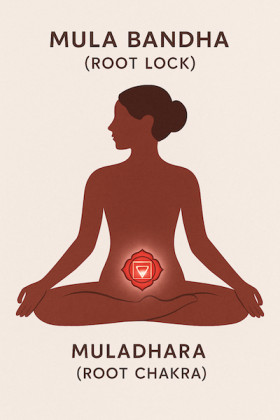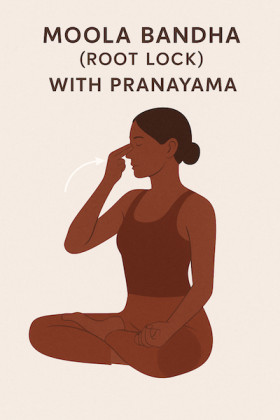
Mula Bandha, also known as the Root Lock, is a powerful yogic technique that involves the subtle contraction of the pelvic floor muscles. Rooted in ancient yogic science, this practice is deeply connected with the Muladhara Chakra (Root Chakra) the energy centre that governs stability, survival, and grounding.
More than just a physical exercise, Mula Bandha activates the flow of prana (vital energy) through the energy channels (nadis), helping to balance key hormones, support the endocrine system, and calm the nervous system. This practice is also essential for Kundalini awakening, as it directs energy upwards through the Sushumna Nadi.
Whether you’re looking to enhance hormonal health, improve mental clarity, or deepen your chakra meditation, Mool Bandha offers a solid foundation to align body, mind, and energy.
Interpretation of mula bandha(Root Lock)
Mula Bandha, or the Root Lock, is a subtle yogic technique that involves the gentle contraction of the pelvic floor muscles, located between the perineum and the sphincter muscles in the pelvic region. This area is closely connected to the Muladhara Chakra, the root energy centre responsible for stability, survival, and grounding.

In Sanskrit, “Mula” means root or foundation, and “Bandha” means lock or bind. Therefore, Mula Bandha is also known as the “Root Lock” or “Perineal Lock”, as it is energetically associated with the Muladhara Chakra, located at the base of the spine.
When you activate this lock, it stimulates the base of the spine, gently pulling the pelvic floor upward. With regular practice, it activates the cervix in women and the perineal body in men, which helps in locating the psychic centre of the Muladhara Chakra.
The primary aim of Mula Bandha is not just physical contraction, but the energetic sealing or activation of the Root Chakra. This lock helps to channel prana (vital energy) upwards and awaken Kundalini energy, making it a key technique in deeper yogic and meditative practices.
Mula Bandha can be performed on two levels:
- Subtle (Psychic) Level – by directing awareness and energy toward the Muladhara Chakra.
- Physical Level – by consciously engaging the pelvic muscles.
The Importance of Mula Bandha
Mula Bandha, often referred to as the energy lock, plays a vital role in managing the body’s subtle energies and hormonal balance. By activating the pelvic floor muscles, this Bandha helps control the flow of lower pelvic hormones, supporting the health of internal organs and aiding in the treatment of digestive issues and sexual disorders.
Mula Bandha does not only benefit the body but also deeply affects the mind. As the body and mind are closely interconnected, the regular practice of this lock promotes mental calmness and emotional stability. It is especially beneficial for individuals experiencing depression, anxiety, phobias, mania, and hysteria, due to its balancing effect on the nervous and endocrine systems.
This Bandha works on a pranic level by regulating and directing vital energy upward. It also helps to harmonise the sexual organs and related hormones, enhancing both physical and psychological wellbeing.
From a spiritual perspective, Mula Bandha aids in awakening the Brahma Granthi, the psychic knot associated with the Muladhara Chakra. Unlocking this knot allows prana (life force energy) to rise through the Sushumna Nadi, supporting Kundalini awakening and deeper states of meditation.
How to practice mula bandha (Root Lock)
To perform Mula Bandha, bring your awareness to the perineum the region between the genitals and the anus. The basic technique involves gently contracting and lifting this area in coordination with your breath.
Note: The perineum is the area between the anus and the genital organs.
Follow these step-by-step instructions to practise Mula Bandha safely and effectively:
Steps
- Begin by sitting in a meditative yoga posture. The most recommended is Siddhasana, where the heel presses against the pelvic region (Muladhara Chakra). However, you can also sit in Vajrasana, Sukhasana, Guptasana, or Gomukhasana whichever feels stable and comfortable for you.
- Take a few deep breaths to relax your body and calm your mind.
Stage 1: Basic Contraction with Breath
- Inhale deeply.
- With the inhalation, gently contract the perineal muscles (or vaginal region in females) and draw them slightly upward, as if lifting toward the spine.
- Exhale slowly, releasing the contraction.
- Repeat the contraction and release rhythmically with each breath.
Tip: This stage engages the entire pelvic floor. Move slowly and smoothly without straining.
Stage 2: Isolate the Perineum Muscles
- Now shift your focus to only the perineum, isolating it from the rest of the pelvic floor muscles.
- Slowly contract this region and hold the contraction for a few seconds.
- Release it gently and breathe naturally.
- Repeat several times.
Goal: To identify and strengthen the specific muscles associated with the Muladhara Chakra, rather than the entire pelvic floor.
Stage 3: Breath Retention with Contraction
- Inhale deeply and hold the breath.
- While holding the breath, gently contract the perineal muscles and hold the lock.
- Maintain this contraction for as long as you can comfortably hold your breath.
- Release the contraction as you exhale.
- Rest with a few normal breaths, then repeat.
Note: Never strain the breath. Stop if you feel discomfort., you can try this for a while, but after some practice, you can increase the time gradually.
The anatomical and physiological aspects of root lock
Mula Bandha engages the pelvic floor muscles, which are structurally similar in both males and females, despite anatomical differences in reproductive organs.
For men, the practice involves placing the heel of the foot at the perineum, specifically between the scrotum and the anus, to gently apply pressure to the root energy centre.
For women, the heel is pressed gently against the outer vaginal area at the perineum. This contact stimulates the Muladhara Chakra, activating the pelvic floor and the associated energy pathways.
Though the external anatomy differs, the muscle architecture of the lower pelvic region is largely the same in both sexes. The area stimulated during Mula Bandha the perineum corresponds closely in function, as the vaginal root in women occupies a similar location as the base of the penis in men.
From a physiological perspective, both males and females experience activation of the same neurological pathways and hormonal responses when practising Mula Bandha. This shared response strengthens the pelvic muscles, stimulates the endocrine system, and directs prana (vital energy) upward through the spine.
Variations
Over time, many yogis have integrated Mula Bandha with other yogic practices, such as asanas (postures) and pranayamas (breathing techniques), to enhance its effects. These combinations not only deepen the practice but also unlock more profound physical, energetic, and spiritual benefits.
While Mula Bandha alone offers significant advantages, when practised alongside specific poses or breathwork, its impact multiplies stimulating energy flow, improving hormonal balance, and supporting deeper states of meditation.
Below are some effective variations of Mula Bandha practised with other yogic techniques:
Mula bandha with pranayama

Combining Moola Bandha with Pranayama (breath control) significantly enhances the benefits of both practices. While pranayama regulates the flow of prana (vital life force) through the subtle body, Moola Bandha directs this energy upward and prevents its dissipation.
This powerful combination allows the practitioner to retain and channel energy more consciously, supporting inner balance and spiritual growth.
When Mula Bandha is engaged during inhalation, it draws Apana Vayu (the downward-moving energy) upward. Simultaneously, Prana Vayu (the upward-moving energy) is brought downward during exhalation. The meeting point of these two energies creates a dynamic internal pressure, naturally leading to breath retention (kumbhaka).
This energetic “collision” is essential for awakening deeper awareness and activating the Muladhara Chakra (Root Chakra).
Practising mula bandha with nadi shodhana
One effective way to integrate Moola Bandha with pranayama is through Nadi Shodhana (alternate nostril breathing). This combination encourages:
- Upward movement of Apana Vayu during inhalation
- Downward movement of Prana Vayu during exhalation
- Kumbhaka (breath retention) where Prana and Apana energies merge
This synergy refines the breath, increases pranic absorption, and prepares the body for deeper meditative states. Over time, regular practice helps awaken the subtle energy channels (nadis) and supports the rising of Kundalini Shakti.
Key Benefits
- Enhances pranic control and retention
- Supports hormonal balance and pelvic organ health
- Promotes deeper mental stillness and energy awareness
- Helps activate the Root Chakra (Muladhara)
With continued practice, this powerful combination can lead to a profound sense of internal bliss, stability, and spiritual growth.
Benefits of mula bandha(Root Lock)
Moola Bandha works by gently engaging the muscles of the pelvic floor, which helps activate the body’s subtle energy and support internal balance. This simple yet powerful practice can improve pelvic health, calm the nervous system, and strengthen the connection between mind and body. Over time, it also helps to stimulate the root chakra, aiding in emotional stability and spiritual growth.
- Stimulates the nervous system
The perineum is the area from where our nervous system begins. It serves as a junction of several major nerves. In Mula Bandha, this region is gently contracted, which stimulates the nervous system and improves its function. This stimulation helps calm the mind, enhances emotional and psychological strength, and provides relief from phobias and negative thoughts. It also boosts concentration power.
- Helps in kundalini awakening
The Muladhara Chakra is located in the perineum region. Moola Bandha activates the flow of Prana and Apana Vayu in this area, which helps stimulate the Root Chakra.
Kundalini energy resides in the Muladhara Chakra. As Moola Bandha activates this chakra, it also stimulates the dormant Kundalini energy.
In addition, the three main Nadis Ida, Pingala, and Sushumna originate from the perineum and extend through all the chakras. These Nadis carry Kundalini energy throughout the body. Moola Bandha activates these Nadis and supports the process of Kundalini awakening.
- Helps to cleanse the body
Mula Bandha enhances the flow of Apana Vayu in the body. Apana Vayu is mainly active in the pelvic and lower abdominal regions and governs the elimination processes—such as excretion, urination, and menstruation. Thus, this practice helps purify and cleanse the body.
- Supports pelvic floor health and spinal stability
Mula Bandha strengthens the muscles of the pelvic floor, which improves core support and spinal alignment. This helps protect the lower back and makes yoga postures more stable and comfortable to hold.
- Enhances sexual health and vitality
By improving blood circulation and energy flow in the pelvic region, Moola Bandha supports sexual health in both men and women. It may help prevent premature ejaculation, increase endurance, and enhance overall reproductive vitality.
- Eases menstrual discomfort in women
For women, Mula Bandha can help relieve menstrual cramps and regulate cycles. Its toning effect on the pelvic muscles helps reduce discomfort linked to hormonal imbalance.
- Promotes hormonal balance
This practice activates the Muladhara Chakra, which influences the endocrine glands associated with sexual and reproductive hormones. It promotes hormonal harmony, reducing emotional stress and improving overall wellbeing.
Research ¹ suggests that the regular practice of Mula Bandha can significantly benefit women with mild-grade Pelvic Organ Prolapse, showing positive therapeutic effects.
Conclusion
Mula Bandha, also known as the Root Lock, is more than just a physical contraction. It is a powerful yogic practice that builds the foundation for spiritual growth, mental clarity, and physical well-being. By activating the Muladhara Chakra and guiding the flow of prana, this practice helps balance the body’s energy, strengthens the pelvic region, and calms the nervous system.
Whether you are seeking inner stability, chakra healing, or better control over your emotions and hormones, Moola Bandha is a valuable tool in your yoga journey. Practising it regularly with breath awareness or pranayama can open the door to deeper meditation, kundalini awakening, and a lasting sense of inner peace.
Frequently Asked Questions (FAQs)
1. When is the best time to practise Root lock?
The ideal time is early morning, before eating, when the body is calm and the mind is clear. You can also practise it during your pranayama or meditation sessions.
2. How long should I hold Root lock(Mula Bandha)?
Start with 5–10 seconds per round, focusing on gentle contraction. Repeat 5–10 times with rest between. As your awareness grows, you can gradually increase hold time.
3. Can beginners practise Root lock?
Yes, absolutely. Beginners should focus on simple pelvic floor engagement first, without breath retention, and gradually deepen the practice over time.
4. Can pregnant women practise Root lock?
Pregnant women can use a gentle version of Mula Bandha lifting without holding breath or pressure. Consult a prenatal yoga teacher or healthcare provider for personalised guidance.
5. Can Root lock help with pelvic floor issues or incontinence?
Yes. Regular practice strengthens pelvic muscles, which may aid mild urinary incontinence and pelvic floor weakness. However, seek guidance if you have severe conditions.
6. Is Root lock(Mula Bandha) safe for everyone?
Generally safe, but avoid strong breath retention or strain if you have high blood pressure, hernia, pregnancy, or recent surgery. Always consult a qualified teacher before advanced practice.
7. How is Root lock different from Kegel exercises?
Both engage the pelvic floor, but Mula Bandha is an energetic and yogic practice that includes breath, intention, and chakra activation whereas Kegels are focused purely on physical strengthening.
8. Can Root lock improve digestion?
Yes. It regulates Apana Vayu, promoting better digestion, elimination, and metabolism. Regular practice may relieve bloating and sluggish bowels.
9. How soon will I see results from practising Root lock?
Some benefits like increased pelvic awareness and calmness can appear within days or weeks. Physical and energetic effects deepen with consistent practice over several months.
10. What should I feel when I practise Root lock?
You may notice a gentle lift in the pelvic muscles and a feeling of grounded energy. Internally you may experience warmth, lightness, or calm as your awareness aligns with the Root Chakra.





Perfectly useful, Thank you a lot
Please add pelvic and cervix areas , representation. And also add spiritual benefits
very useful information for a healthy and blissful life on earth